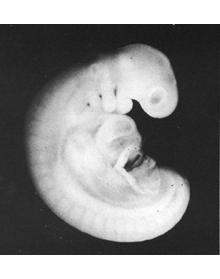The Stages of Human Embryonic Development
Stage 12 embryos have a greatest length similar to embryos from stage 11 with most embryos being in the 3 to 4 mm range. This is due to the fact that much of the growth during this stage is in the thoracolumbar region which leads to an increasing curvature of the embryos rather than an increase in greatest length. Stage 12 embryos have an estimated postfertilization age of 29 to 31 days.
The characteristic feature of stage 12 is the presence of 21 to 29 body segments (somites). In the older specimens the caudal neuropore is closed and secondary neurulation has begun. Most of the cephalic neural crests can be identified. The otic vesicle forms but may remain connected to the overlying ectoderm. The sinu-atrial openings and atrioventricular canal are present in the heart. Trabeculation has begun in the ventricular walls. The aortic arches are present and the dorsal aortae are fused. Four pharyngeal arches, grooves and pouches are present. Future hepatic sinusoids are occupied by hematopoetic tissue and the mesonephric duct terminates caudally in the cloaca.
| Browse the section images |
| 3D reconstructions |
| More info ... |
